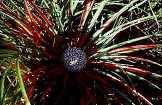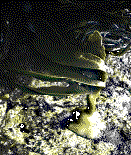Habitat of the Marine Otter
This account is taken from
Cabello in
Otters: Proceedings of the First Working Meeting of the Otter Specialist Group (1977),
and
Larivière (1998).
 This species is found in the temperate coastal and tropical coastal biomes. They prefer to live along rocky coasts of irregular topography, exposed to heavy swells and strong prevailing winds (northeasterlies, westerlies and southwesterlies). They like large, rocky outcrops with lots of crevices and caves to hide in, and which harbour prey. Steep but stable rocky slopes and cliffs are favoured - Marine Otters make no use of sandy beaches except when travelling across them to other rocky areas.
This species is found in the temperate coastal and tropical coastal biomes. They prefer to live along rocky coasts of irregular topography, exposed to heavy swells and strong prevailing winds (northeasterlies, westerlies and southwesterlies). They like large, rocky outcrops with lots of crevices and caves to hide in, and which harbour prey. Steep but stable rocky slopes and cliffs are favoured - Marine Otters make no use of sandy beaches except when travelling across them to other rocky areas.
 The otters range up to 30m (100') inland, and like a dense vegetation of shrubs and bushes such as Giant Rhubarb (Gunnera chilensis), Greigia spacelata and Fuscicularia bicolor, the most southerly members of the Pineapple family (Bromeliaceae), the Chilean Guava (Ugni molinae), Raphitanus spinosus and the Olivillo or Palo Muerto (Aextoxicum punctatum) - all plants that like poor soil.
The otters range up to 30m (100') inland, and like a dense vegetation of shrubs and bushes such as Giant Rhubarb (Gunnera chilensis), Greigia spacelata and Fuscicularia bicolor, the most southerly members of the Pineapple family (Bromeliaceae), the Chilean Guava (Ugni molinae), Raphitanus spinosus and the Olivillo or Palo Muerto (Aextoxicum punctatum) - all plants that like poor soil.
 The tidal range is about 2 - 2.5m (6-8'), and in the littoral zone, a dense growth of green algae such as various Sea Lettuces (Ulva spp) harbour plenty of prey. Further offshore, in the sublittoral zone, grow dense stands of brown algae such as the Giant Kelp or Cochayugo (Durvillaea antarctica), Chilean Kelp or Chascon (Lessonia nigrescens) and Brown Kelp (Macrocystis perifera), again supporting a high diversity of bivalves, gastropods, crustaceans, echinoderms and coelenterates along with the fish that prey on them.
The tidal range is about 2 - 2.5m (6-8'), and in the littoral zone, a dense growth of green algae such as various Sea Lettuces (Ulva spp) harbour plenty of prey. Further offshore, in the sublittoral zone, grow dense stands of brown algae such as the Giant Kelp or Cochayugo (Durvillaea antarctica), Chilean Kelp or Chascon (Lessonia nigrescens) and Brown Kelp (Macrocystis perifera), again supporting a high diversity of bivalves, gastropods, crustaceans, echinoderms and coelenterates along with the fish that prey on them.
From these rather exacting requirements, it is not so surprising that populations of otters tend to be isolated as suitable habitat is unlikely to be contiguous.
Hernandez, reported in Brownell in IUCN: Otters (1977) says that this species has been known to go up freshwater rivers to 650m (2000') above sea level in search of prey, so they obviously are able and willing to exploit this kind of habitat.
| Marine Otter |

